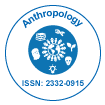
Anthropology
Open Access
ISSN: 2332-0915

ISSN: 2332-0915
Commentary - (2025)Volume 13, Issue 1
The Paleolithic period, often referred to as the Old Stone Age, represents the earliest and one of the most profound phases in human history. One of the defining features of the Paleolithic was the use of stone tools, which marks the beginning of the archaeological record for human activity. Early hominins, such as Homo habilis, began crafting rudimentary tools by striking stones to produce sharp edges. These tools were used for cutting meat, scraping hides, and processing plant material. Over time, tool technology evolved significantly. By the Middle and Upper Paleolithic, Homo erectus and later Homo sapiens had developed more sophisticated implements, including hand axes, blades, and composite tools made of multiple materials like bone, wood, and stone. These advancements illustrate not only the growing technical skill of early humans but also their ability to adapt to various environments and resources.
The Paleolithic period was also characterized by a nomadic lifestyle centered around hunting and gathering. Human groups moved across landscapes in search of food, following seasonal patterns of animal migration and plant growth. This mobility fostered a deep knowledge of the natural world, including animal behavior, ecological cycles, and the properties of various plants. Paleolithic peoples relied heavily on cooperation and social organization to survive. Group hunting required strategic planning, communication, and the ability to share resources equitably. These early social structures formed the basis of communal living, where survival depended on collective effort rather than individual competition.
The mastery of fire was one of the most significant technological and symbolic achievements of the Paleolithic era. Fire provided warmth in cold climates, protection from predators, and a means of extending activity into the night. It transformed the way humans interacted with their environment and with each other. The hearth became a central place for gathering, storytelling, and passing down knowledge. Fire also likely played a role in the development of ritual and spiritual beliefs, symbolizing life, transformation, and the mysterious forces of nature.
Cognitive and symbolic capacities expanded dramatically during the Paleolithic. The archaeological record reveals the presence of early art, personal ornamentation, and ritualistic behavior. Cave paintings such as those in Lascaux, Altamira, and Chauvet demonstrate a sophisticated understanding of form, color, and movement. These works, often depicting animals and abstract symbols, suggest that early humans were capable of abstract thought, symbolic representation, and possibly even shamanistic or religious practices. The creation of figurines, such as the Venus of Willendorf, reflects early ideas about fertility, gender, and the human form. These artistic expressions indicate that Paleolithic humans were not only concerned with survival but also with meaning, identity, and aesthetics.
Social life in the Paleolithic was likely organized around small, kin-based groups or bands. These groups shared responsibilities and resources, maintained close interpersonal relationships, and enforced social norms through informal mechanisms. While we cannot reconstruct Paleolithic social structures with complete accuracy, ethnographic analogies with contemporary hunter-gatherer societies suggest that these communities valued cooperation, egalitarianism, and mutual support. Leadership was likely situational rather than institutional, with individuals gaining influence through skill, experience, or charisma rather than formal authority. Gender roles may have been more fluid than commonly assumed, with both men and women contributing to subsistence and social life in diverse ways.
Citation: Scholz A (2025). Ecological Intelligence and Foraging Strategies Among Paleolithic Populations. Anthropology. 13:260.
Received: 03-Mar-2025, Manuscript No. ANTP-25-38240; Editor assigned: 05-Mar-2025, Pre QC No. ANTP-25-38240 (PQ); Reviewed: 18-Mar-2025, QC No. ANTP-25-38240; Revised: 05-Mar-2025, Manuscript No. ANTP-25-38240 (R); Published: 01-Apr-2025 , DOI: 10.35248/2332-0915-25.13.260
Copyright: © 2025 Scholz A. This is an open-access article distributed under the terms of the Creative Commons Attribution License, which permits unrestricted use, distribution, and reproduction in any medium, provided the original author and source are credited.